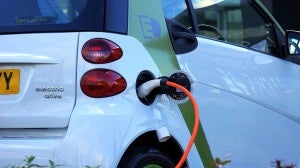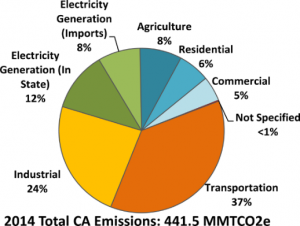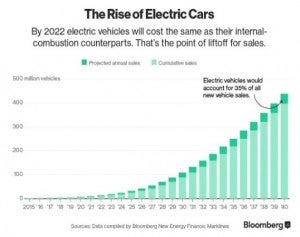 Calvin Bryne co-authored this post.
Calvin Bryne co-authored this post.
As with other environmental policies, California leads the nation in encouraging electric vehicle (EV) adoption. The state has made huge strides in promoting cleaner cars, and opportunities remain to fully tap the benefits of this clean energy resource.
California as a model for national policy
In California, vehicles are responsible for almost 40 percent of total greenhouse gas emissions, making transportation the state’s greatest sole contributor to climate pollution. The enormity of this problem was an impetus for California becoming the first state to adopt comprehensive vehicle emissions standards in 2009. Modeled largely after California’s regulations of the same name, the federal Clean Car Standards set national greenhouse-gas reduction goals for vehicles made between 2017 and 2025, and established incentives for manufacturers to produce technologically-advanced new cars.
The standards aim to improve vehicle fuel economy and reduce harmful climate change-causing pollution. Last month, the U.S. Environmental Protection Agency (EPA) and National Highway Traffic and Safety Administration (NHTSA) released their midterm review of America’s Clean Car Standards. The review brings good news: the U.S. is on track to achieve both of these critical goals.

1 California Air Resources Board, California Greenhouse Gas Emission Inventory – 2016 Edition
Notably, the midterm report finds by the year 2025, the Clean Car Standards will eliminate six billion metric tons of climate pollution – nearly double our nation’s fuel economy performance – and save Americans $1.7 trillion at the pump.
Likewise, policymakers are looking to California as a model when it comes to transitioning the nation to EVs.
Putting electric vehicles in the fast lane
Replacing fossil-fueled cars with EVs reduces reliance on petroleum and decreases the amount of carbon dioxide and other harmful pollutants in the atmosphere. So, ensuring customers have access to affordable, functional EVs is a key step in any comprehensive plan to reduce emissions from transportation.
In addition to the Clean Car standards, California has taken significant action focused directly on promoting the use of EVs:
- Governor Jerry Brown’s 2012 Executive Order established a goal of 1.5 million zero-emission vehicles in California by 2025.
- SB 350 called for widespread electrification of transportation and set concrete emissions-reduction goals.
- SB 1275 focused on ensuring low-income and disadvantaged communities are able to benefit from EVs and charging infrastructure, as they are most likely to be burdened by harmful transportation emissions.
Spurred by these state policies, EV offerings in California make up an increasingly large share of the market and are becoming more technologically advanced. In 2009, only one light duty EV – the Tesla Roadster – was available to U.S. customers. Today, more than 20 models are available, accommodating multiple customer price and battery preferences.
In addition, regulatory actions have further bolstered EV purchases: the California Public Utilities Commission (CPUC) and California’s utilities have developed promising pilots aimed at increasing statewide charging infrastructure and EV adoption.
Roadblocks
Despite progress, California faces barriers currently impeding widespread use of EVs – a key part of meeting California’s long-term climate and clean energy goals:
- Infrastructure – One of the biggest roadblocks to increased EV adoption is the current low number of charging stations in the state – meaning drivers aren’t assured that they can get to and from their destination without being stranded. Currently, California still only has about 3,900 charging stations. We must increase the number of charging stations dramatically for California to meet its emissions-reduction goals. These include EV-charging installations at single family homes of EV owners, but also at workplaces, apartment buildings, and other shared spaces. While SB 1275 will encourage charging infrastructure in disadvantaged communities, state policymakers and regulators should continue to prioritize EV expansion in these communities. Thankfully, the CPUC – in cooperation with utilities and private companies – is facilitating the installation of more charging stations throughout the Golden State by implementing the pilots described above.
- Cost-competitiveness – The cost of producing EVs has fallen steadily, but their sticker price is currently higher, on average, than their gasoline-powered counterparts (though their cost over time, taking fuel prices into consideration, has been shown to be lower). While the transportation industry has made tremendous strides in lowering costs of battery technology, they must continue to make advancements in developing attractive financing options, and enhancing marketing, education, and outreach to facilitate increased customer engagement.
- Grid balance – EV batteries can store electricity when renewable energy is plentiful and electricity is at a lower price, and then use it when demand and prices rise. This helps reduce the need for dirty generation and expensive grid upgrades to accommodate higher demand. However, shift in customer behavior is critical. Without it, EV charging will actually increase demand on the grid at peak hours, potentially resulting in more pollution. As a solution, the CPUC has begun taking steps to make time-of-use electricity pricing the default option in California. Time-of-use pricing makes electricity cheaper when it comes from clean energy resources and more expensive during predictable times of peak demand when electricity comes from dirtier sources. This transition will benefit the grid by better incentivizing customers, including EV owners, to use electricity when it is cleaner and more affordable.
California has a longstanding history of pioneering advancements in clean energy solutions, and current progress in the state’s transportation sector offers an optimistic glimpse into the future. EVs today are less costly and more reliable than ever before, meaning they are well on their way to displacing a large portion of dirtier passenger vehicles. To be able to witness these changes across the state and the nation, it is imperative we maintain forward momentum and tackle barriers to increased EV adoption. In doing so, we will help ensure California – and the nation – are headed down the right road toward a clean energy future.
Enviroshop is maintained by dedicated NetSys Interactive Inc. owners & employees who generously contribute their time to maintenance & editing, web design, custom programming, & website hosting for Enviroshop.

